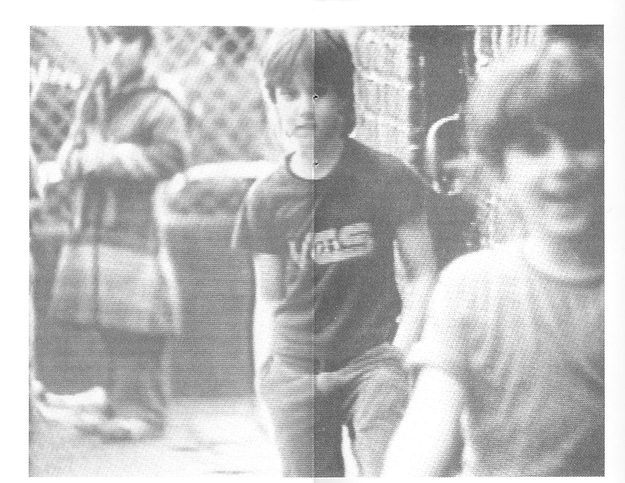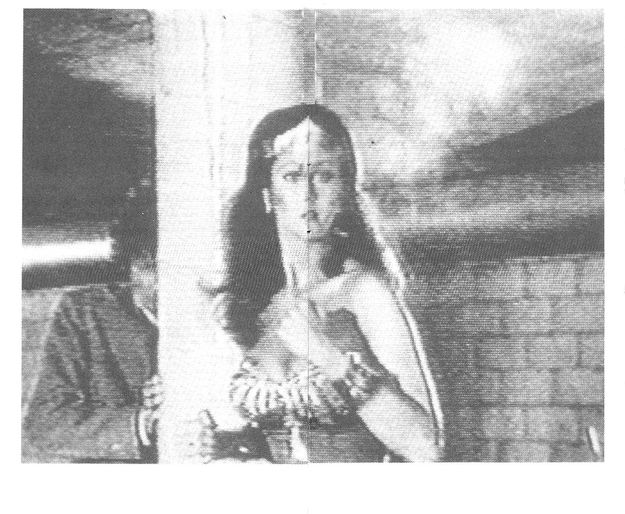VELTHOVEN: When you started to work with video in 1977 you mainly dealt with TV, you were 'talking back to the media'.
BIRNBAUM: No I think that never was the main subject. I wanted to talk about a form of representation and its issuance. For instance in the case of Wonderwoman: what does it mean to have a woman on TV, in a very popular TV show, and this woman transforms three times an hour by just twisting and turning around in a burst of light, that was what I wanted to talk about.
It wasn't about media per se, it was about this form of representation which is presented thru media, not only TV but also magazines, or film. The reason I took television first was because it was the most popular vocabulary in the US at that time. When I looked around in the Arts, a lot of people were attempting to bring about what is called New Image; isolating an object or a person as object from the screen or the dimension of television or film, people like Robert Longo or even Cindy Sherman as well. I wanted to talk about the form of language that was the most popular and dominant at that time in America so I used that as the vocabulary of the work. When I saw people trying to tackle for instance the content of a film, frequently it was done by translating it into a different medium. such as photography, drawing etcetera. It looked more estheticized to take this and put it into a painting or a type of framework that was already being dealt with. I thought it was really necessary to have the medium itself provide the vehicle.
And also I feel it is important, if a form of language and comment is being articulated at you, that you have the ability to also use it.
And I didn't feel I needed to, for instance, set up a shot like the Wonderwoman, of someone in that type of suit, running through a forest, or exploding. I didn't have the money nor the desire to do it.
VON BRUCH: Yes that was also part of the reason I used pirated footage: because I couldn't buy a colour-camera, and I wanted to work in colour because that was an adequate answer to what was happening on television.
It's a bit like Schwitters cutting out some ad's and gluing them together.
BIRNBAUM: Yeah, it has to do with economy of means. The art in the twentieth century is going through the necessity to look at the process of an-making. I think throughout history, depending on the situation of the creative individual in the society, they found different means to do it. It is a comment on the condition of the time. When the thing that affects your life the most is the type of architecture of the media, than that's where, as a critical artist, you want to look toward.
It's a bit of two sides: the process is economical but also says something in the process of taking it. For me, I don't cut up like Life magazine because I want a Redhead in my shots, it's more the taking out of the caracter from the object, to examine it and to look at it. To abstract it to its essence.
A reason I stopped using media-footage is that now video equipment is much more available. And I felt that people would do themselves some of the playing with the ability to manipulate the image like I showed that could be done. I really think they'll do. I'm not saying for what purpose or intention, but to play, because now when I look into every magazine, they are selling it with slogans as: Take your own home pictures, now you can become your own film-maker. Damnation of Faust - Birnbaum, Dara. 1984. Published in Mediamatic Magazine Vol. 1#1 (1986)

VON BRUCH: I even saw them advertising it recently as For Video-Artists.
VELTHOVEN: That was the only reason you stopped referring directly to TV?
Birnbaum: Well I don't use the actual television image anymore but it's still the same medium.
And the essence of that early work, it was always about the search for an identity, is still in the things I do now.
I used to be what you call a quick editor and I thought, this is like an implosion if we take it any quicker... some of my friends, they stayed in there and made it faster still, but I thought it was essential to provide an alternative. So I made very slow tapes, and still they are going slower and slower.
So I wanted to stop using just the convention of television, and when I was in Amsterdam and visited the Van Gogh Museum I saw the Japanese prints and I saw the richness of the ability to communicate in that visual language, and I saw the format... some seemed almost like if you stop a moment of TV-time. And at that time, in the eighteenth century, they were mass-produced! This led me to a different, but very formal convention.
By now my work is much softer, although it's the same hard technology. I try now, when I take a girl from the streets, to look at the smallest kind of gesture, because I, almost, felt I had to go backwards. And, like someone said, this footage looks like experimental film footage, inside a very hard casing of technology, instead of trying to be as hard as the technology itself or to compete with it.
I thought it was important to go back to simple things but not simplistic things, that if everyone is so filled with the visual effects, in every way, that are provided, that in fact I would like someone to look aside, and see the most everyday common experience. I don't think it's the end answer at all, but I think that in a period of interruption like this is, for me it was the only way that I could go.
VON BRUCH: The fact that it's on tape makes people perhaps look at it, rather than going out and see that. Only on the media you get recognition, not outside.
BIRNBAUM: I think it's the package, I think the important point is not the media, it's the fact that media is distributed. It's just that if you go to see a work in a museum, it already has a kind of envelope as Art, so you don't have to talk about that, and you can talk a little more about the content...
I think the architecture of today is in the media, the spatial relationships and the way we relate to it... so in that way it's important to stay on the media instead of like I said translating it to painting or to photographs. In the use of it you will most probably on some level, as KLAUS said, reach the people who are generally reached by media.
It depends, I think, on how you see the need to change what is happening in society, and for me I think I am, I am a very nervous person about what's goin' on now. I don't feel that positive and I'm not so sure how much time, you know, we have to keep talking. So I thought rather than pointing the finger, rather than Talking Back at something, it is more important to Talk With...
If you'd like to quote something: Velthoven, Willem. "To Talk Back or to Talk With." Mediamatic Magazine vol. 1 # 1 (1986).
